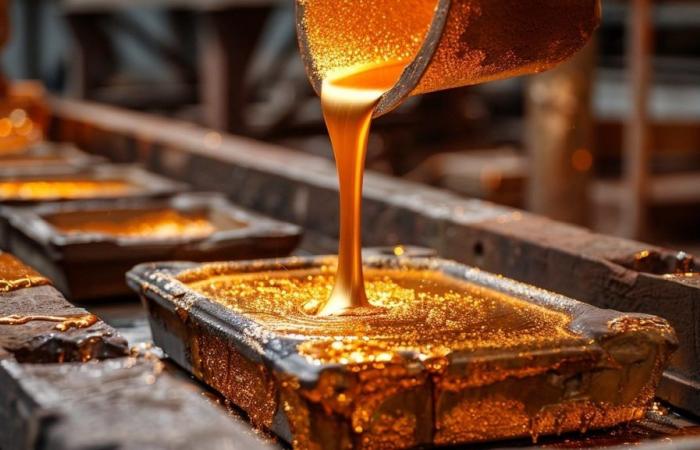Once the price of gold it was linked to the performance of the Treasury bonds Americans and therefore to expectations on US inflation and interest rates. It routinely moved in the opposite direction of 10-year Treasury bond yields. On the morning of Monday 24 June the yellow metal traded slightly higher at around 2,338 dollars an ounce. This time however, it followed the upward trend in rates. Its value has risen, according to the latest report from the World Gold Council, due to the level of record question by the central banks of China, India, Türkiye and emerging countries. The Chinese central bank alone would have purchased gold for 18 consecutive months from November 2022, increasing its gold reserves (valued at 3,400 billion dollars) by 16%, for a value of 561 billion dollars.
Gold, a precious asset in the event of sanctions
But the gold question would not have to do with the process of de-dollarizationbut rather with the need for non-aligned countries to diversify reserves with a non-seizedable asset. The freezing of the Russian Central Bank’s foreign exchange reserves in 2022 would have pushed the central banks of non-Western countries towards buying gold. According to data reported by Wall Street Journalstarting from the third quarter of 2022, excluding China, the first buyer, the only ones Emerging countries they would have added 2,200 tons of precious metal to their reserves worth $170 billion, equal to a fifth of global demand and double the percentage recorded between 2012 and 2021.
There gold-sanctions correlation is proven historically by an interesting paper from the International Monetary Fund: «Can gold as an international reserve still be defined as a barbaric relic?» by Serkan Arslanalp, Barry Eichengreen and Chima Simpson-Bell, released in January 2023. Historically, the authors argue, the accumulation of gold by central banks is closely linked to the fear of Western financial and trade sanctions (Serbia 2002, Belarus 2006 , Iraq 2012, Egypt 2017, Turkey 2018).
Global reserves declining
Furthermore, it is erroneous to think that reserves of central bank gold are at an all-time high. In 1950, in advanced economies, gold represented on average 80% of reserves, today we are around 17%. Some countries hold more (60%) such as Italy, Germany and the United States, and others less (between 4 and 9%), such as China, India, the United Kingdom, Switzerland and Japan. It is interesting to note how the Swiss from 1999 to 2021 it sold 34% of its reserves valued in gold, but remained the largest center in the world for refining and transforming the precious metal. There China it went from 3% in 2022 to 5% in 2023, still below the levels recorded historically, in the period 1950-1990. And what’s more, the gold market has become even more fluid with the birth, in addition to the already well-known stock exchanges in London, New York and Tokyo, of the Shanghai Gold Exchange, the Multi Commodity Exchange of India and the Singapore Precious Metals Exchange.
But theRussian gold he managed to find a way out, despite the sanctions. Moscow was downgraded from the London Bullion Market, which is still the main global over-the-counter market that sets the benchmark price of gold in dollars per troy ounce, and was also kicked out of the London Bullion Market Association which provided it with the quality standard «good delivery». But he found a intermediary in the United Arab Emirates, thanks to which she managed to sell her uncertified gold. Switzerland imported Russian gold worth $8 billion from Dubai in 2023.
De-dollarization underway?
The ongoing (partial) de-dollarization would instead be dictated not by the purchase of gold, but by the sustainability of the long-term American debt (35 trillion dollars), and by the recent rate increase Fed, which made the dollar too valuable for many emerging countries. Again according to the IMF, the percentage of dollars in reserves in the world has gone from 70 to 55% in twenty years, but purchases by many central banks of non-traditional currenciesincluding the Australian dollar, the Canadian dollar, the Singapore dollar, the Chinese renminbi and the South Korean won.
Some South American countries such as Brazil, Argentina and Bolivia have started paying for imports in yuan. Indian refiners have started paying in rupees for Russian oil purchased through traders in Dubai. There Chinese currency it then recently supplanted the dollar as the most traded currency in Russia, accounting for 42% of all foreign currency traded on the Moscow Stock Exchange. Russian state oil company Rosneft reportedly issued 10 billion yuan of bonds in September 2022, followed by a second tranche of 15 billion in March 2023, and Saudi Arabia accepted payment in other currencies for the sale of its oil.
But we are far from one dethronement of the dollar, according to Jared Cohen, president of the Goldman Sachs Global Institute, who claims in a recent article in Foreign Policy «Don’t Bet Against the Dollar», that the greenback still reigns supreme in global trade, with a share of 88% in currency transactions. The global system of oil financing, insurance and transportation remains almost entirely dollar-based.
The cross-border interbank payment system (Cross-Border Interbank Payment System, CIPS) created by China as an alternative to SWIFT, manages 25,900 daily transactions, compared to the 500,000 managed by the Belgium-based company for a total value of 1,800 billion dollars. And the share of the renminbi in international trade does not exceed 8%, due to its slow internationalization process. (All rights reserved)
Posting time: 06/24/2024 11:54
Last update: 06/24/2024 1.04pm





